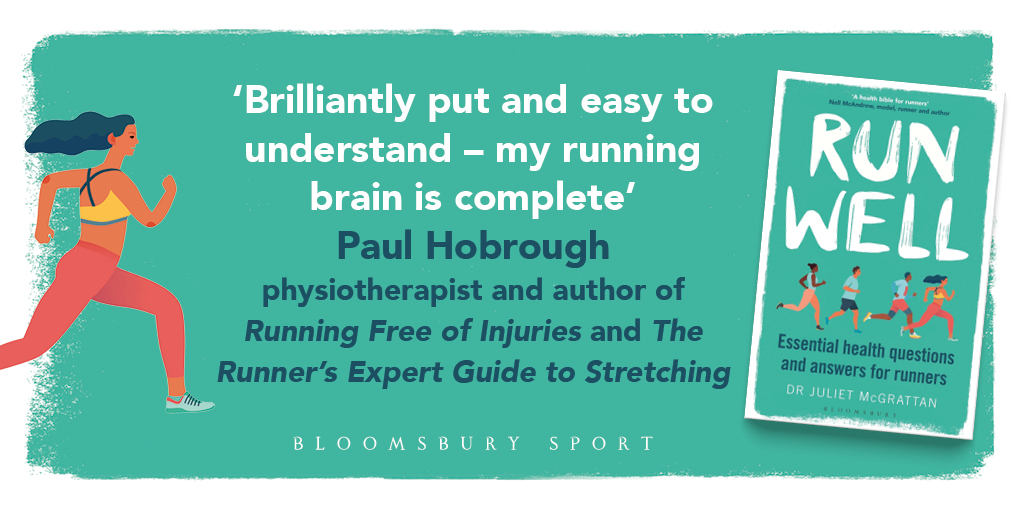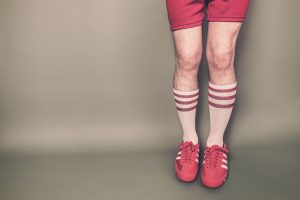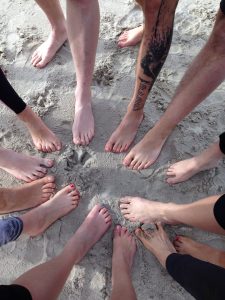My recent marathon was a great reminder of exactly how painful and comical Delayed Onset Muscle Soreness (DOMS) can be! Standing at the top of a set of stairs and looking down them wondering how on earth I was going to get to the bottom. One hand on the wall as I winced, lowering myself onto the toilet seat. The sensation that my legs weren’t fully in my control and might just fold underneath me when I put weight on them. I had to laugh… or I’d cry!
In some ways, it’s a badge of honour, a reminder of how hard you’ve pushed yourself, the challenge you’ve risen to. If you felt fine you’d be wondering what else you could have given on the day. But, it is painful, makes normal life difficult and does make you wonder if running a long way is good for you.
Here’s a quick recap of what DOMS is, whether you can prevent it and what you can do to treat it.
What is DOMS?
DOMS stands for Delayed Onset Muscle Soreness which usually kicks in on day two after intense or long exercise that is more than your usual workout. It peaks around day three and resolves by day five to seven. We used to think that this muscle pain and tenderness was due to a build-up of lactic acid, a waste product produced by muscles during exercise, however, we now know that lactic acid clears quickly, within a couple of hours of exercise. It’s actually much more of a mechanical cause.
Although exercise makes you fitter and stronger, during the activity itself, your muscles are put under stress and ‘damaged’. The muscle fibres sustain micro-tears. After exercise, your body wants to heal the tears and to strengthen the muscle fibres so they can cope with an increase in workload next time. Part of the healing process is to trigger inflammation. Extra tissue fluids and blood cells are sent to the area to get to work. This causes swelling and tightness and is what makes your muscles feel so stiff, sore and tender.
When the inflammation reduces, the swelling eases and muscles can move more freely again.
How can you treat DOMS?
Time is definitely the greatest healer of all. DOMS will go on its own, even if you don’t do anything at all. Treatment is really about easing the discomfort and making you feel more comfortable while the internal repair processes are at work. Here are some things you can try:
- Warm baths
- Cold baths or ice packs
- Frequent easy walks
- Gentle massage
- Paracetamol
- Elevating your legs
- Light compression
- Drinking plenty of fluids
How can you prevent DOMS?
Not having to crawl around for a few days after an endurance event would be a bonus and reducing pain can never be a bad thing but preventing DOMS happening is easier said than done.
The biggest factor and the best way to prevent DOMS is to train well for the distance you’re running. If you’re undertrained, you’ll probably be more affected by DOMS. Increasing your miles gradually, letting your legs adapt to the increasing distance and intensity, slowly, week after week, with good recovery, is your best bet. Runners who frequently cover very long distances don’t spend a week groaning every time they turn over in bed or rise out of a chair! Having said that, most runners don’t run the full 26.2 miles before a marathon, and most coaches don’t recommend it. I was well trained up to 20 miles, I had virtually no muscle pain after that longest training run. But, the extra 6.2 miles and the increased pace I ran on marathon day was sufficient extra load for my muscles to bring on the DOMS big time.
Warming up before you run and stretching after a run doesn’t seem to prevent DOMS or make it any less severe. Cooling down properly or having an ice bath straight after your run might help but the evidence isn’t clear and I certainly need it to be overwhelming before I’m going to plunge into cold water! The same can be said for a post-race massage and wearing compression gear during the run. There is no magic preventative. Of course we’re all different and it can be a case of trial and error and seeing what works for you.
Is DOMS a good thing?
When it comes to both preventing and treating DOMS, we need to question whether we want to reduce the inflammation. Reducing it can make us feel better and more comfortable but it’s the body’s response to damage and it’s not a bad thing. Extra blood cells and tissue fluid do cause the muscles to swell but they’re brought to the area for a reason – to promote healing. Taking an anti-inflammatory such as Ibuprofen within 48 hours of any musculo-skeletal injury can slow down the healing process and paracetamol is recommended as the best option. Can we say the same for reducing swelling with ice and compression? We don’t have all the answers and it’s usually a case of managing pain relief and function, of course we shouldn’t suffer!
If you have pain that goes on more than a week or is localised to one area then it may be an injury rather than DOMS so get a medical opinion.
Can I run with DOMS?
It’s best to wait until your DOMS has resolved before you try to run again. The pattern of your muscle activation can change and might put more stress on tendons and ligaments which can put you at an increased risk of injury. Keeping moving however can ease discomfort so stick to walking or have a gentle swim if it feels good. You could exercise the muscles which aren’t sore so think about an upper body work instead. I like to think of DOMS as my body’s way of protecting itself, stopping me doing something which might hinder my recovery. And, after all, it wouldn’t be the full marathon experience if you could skip happily down the stairs the next morning would it?!
If you’ve enjoyed this blog post, you’ll love my book Run Well: Essential health questions and answers for runners, published by Bloomsbury and available everywhere you buy books.

Featured photo by Samuel Figueroa via Pexels








I still remember the DOMS after my first marathon. I could hardly walk and even sleeping was uncomfortable.